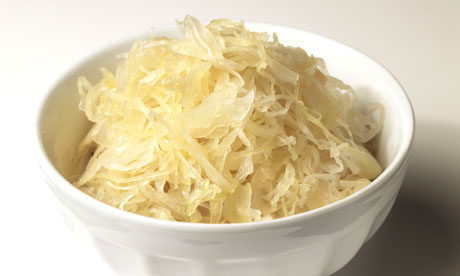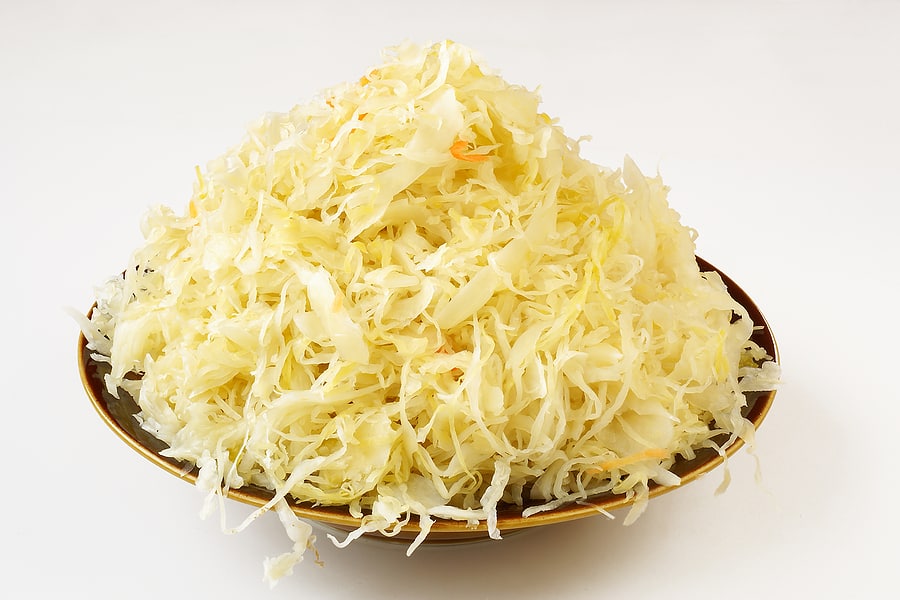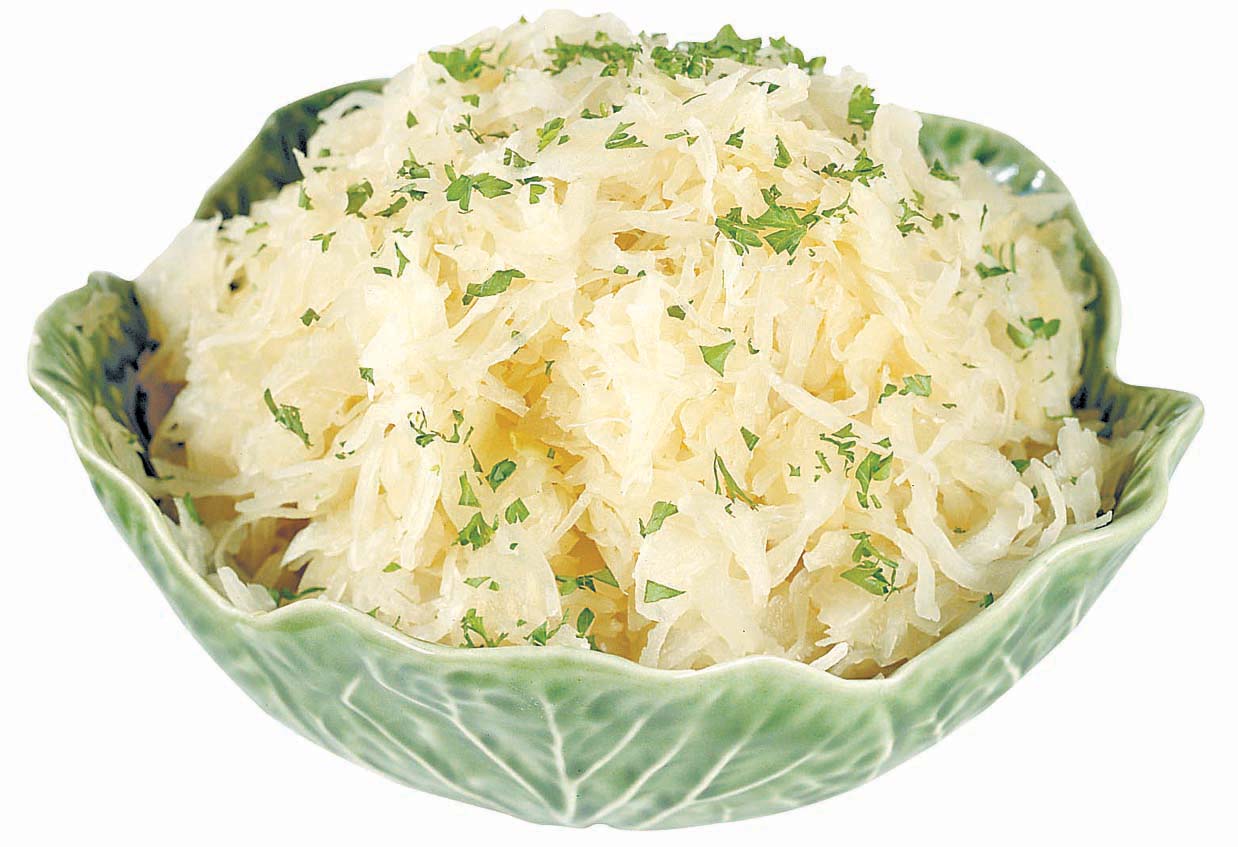Sauerkraut
Sauerkraut [ zaʊ.ɐ.kʁaʊt ] or sauerkraut is eaten by the lactic fermentation of preserved cabbage or cabbage, and is usually cooked as a side dish. It is regarded internationally as one of the best-known German national dishes.
Ingredients
Sauerkraut is rich in lactic acid, vitamin A, B, C, K and minerals and with the carbon one important indigenous vegetables vitamin C supplier in the winter. Sauerkraut is very low in calories ( about 80 kJ (19 kilocalories) per 100 g ), virtually fat-free, contains 3-4 % carbohydrates and 1-2 % protein. The histamine also contained can trigger incompatibilities.
History
To preserve vegetables by lactic acid fermentation is a very old, practiced in different regions of the world technology. In ancient Greece and the Roman Empire so soured cabbage was known, as in China.
As early as 1270 the sauerkraut in the narrative Meier Helmbrecht is mentioned:
From the Greek natural philosophers is known that they recommended sauerkraut.
Sauerkraut belonged to the establishment of newer methods of preservation to mainly processed in Germany, the Netherlands and Poland in the winter ingredients. It came also in the Jewish kitchen. Especially in Eastern European countries very much sauerkraut is eaten. Due to its high content of vitamins ( especially vitamin C) leaned it against the winter deficiencies. Therefore, it was also used throughout the year as provisions in the seafaring, after it was discovered in the 18th century that the consumption of raw sauerkraut prevents scurvy.
Especially during the time of the Second World War, the stereotypical name herb for German (or herb for German ) was in the English language often used, which is probably the result of traditionally high consumption of sauerkraut during the winter months in central Europe, especially in Germany due.
Fresh cabbage is cut into fine strips, in a pot. With an herb masher one breaks the plant cells: the cell sap can leak and eventually cover the cabbage completely. Attached salt withdraws during the fermentation process the cabbage liquid and preserves the juice to the fermentation (fermentation ). With sauerkraut or sauerkraut additionally some white wine is added. The brine covered during the whole fermentation, which takes about four to six weeks, the white cabbage. It is important that no air remains between the fresh cabbage, otherwise could start instead of the desired acid fermentation a rotting process. That is why sauerkraut must be vigorously pounded and pressed with weights.
Originally used to earthenware pots for cooking. To allow air and with a simultaneous escape of gases, the sauerkraut pot has a circumferential water-filled trough. The attached lid completely immersed in the water and prevents the entry of air. With overpressure, the gas bubbles escape to the outside.
Since the late 19th century is one sauerkraut industrially produced, first in wooden barrels, today in airtight Gärsilos. The oldest German sauerkraut factory is the company Leuchtenberg from Neuss. There Sauerkraut is traditionally produced since 1861. Today's man-made sauerkraut is often added another vitamin C as an antioxidant. The shelf life is increased.
The present in the air and adhering to the cabbage lactic acid bacteria bring the fermentation process in motion. In today's common hygienic production and storage conditions, a separate addition of the bacteria may be present in order to avoid errors in fermentation. The type Leuconostoc mesenteroides used also uses the dairying.
The end of the fermentation is divided into three phases:
Preparation
In raw sauerkraut are still most of the vitamins and minerals of white cabbage contain. It is available separately at butchers, health food shops and markets. Otherwise, sauerkraut comes as a permanent preserve in cans, jars, or in sealed plastic bags in the trade.
Sauerkraut is steamed with a little water or broth and fat for about half an hour. Common spices - along with salt and pepper - laurel, juniper, caraway, cloves, marjoram, tarragon, fennel seed, savory or sugar. Depending on the region even ingredients such as onions, apples or grapes may be added. In Hesse, which is for example apple juice and beer in Thuringia.
Many appreciate especially warmed sauerkraut: Prepared in the eve it tastes changed significantly, especially it is softer.
Dishes with sauerkraut
- The Hessian ribs with sauerkraut pickled pork chop is simmered in sauerkraut.
- Sauerkraut is an important part of Bavarian cuisine, usually flavored with caraway and often slightly bound with roux.
- Sauerkraut is part of the Swabian cuisine. The Filderstadt south of Stuttgart are one of the most famous area for growing cabbage ( Filderkraut ). In Leinfelden is celebrated each year the Filderkraut hard. Also typical of the Swabian food are noodles ( schwäb. " Buabaspitzla " ) and often bacon for sauerkraut.
- In the Berlin - Brandenburg cuisine, there are a lot of sauerkraut.
- In Franconia repeatedly boiled sauerkraut receives pieces of meat. You give a good flavor.
- Klunz is a medium German court with sauerkraut, and lard.
- The sauerkraut in Saxony is similar to the Frankish, but is often flavored with caraway.
- Alsatian sauerkraut is a particular specialty, almost the main ingredient - still quite raw and quite light
- In Szeged goulash Hungarian cuisine is goulash mixed with lots of sauerkraut and a little sour cream.
- An essential part of the Polish national dish bigos is sauerkraut.
- Bernerplatte and Swiss plate.
- In Austria the peasant feast, with blood sausage ( Austrian Blunze ), roasted and cured meats, plus dumplings.
- In Austria, for roast pork with potato dumplings.
- In the Czech Republic the national dish " Vepro - knedlo - zelo " ( roast with dumplings and cabbage ).
- In the part of Württemberg Heilbronn - Franconia sauerkraut casserole is often prepared. Here, the sauerkraut is alternately layered with coarse liver sausage and mashed potatoes in a casserole dish and then baked in the oven until the top layer of mashed potatoes dyed light brown. Serve with bread and noodles.
- In the Balkans (especially Romania, Bulgaria and Serbia) Sarma is popular: be acidified whole cabbages " defoliated ", these sheets are filled with a spicy stuffing of rice, then cooked in sauerkraut in the oven or cooked in a sweat fluid.
- In the U.S., the Reuben sandwich is widespread. It consists of rye bread with corned beef, sauerkraut, Swiss cheese and salad dressing and roasted before consumption with all the trimmings.
Further use
- Sauerkraut juice is a juice made from pressed vegetables, raw sauerkraut. Sauerkraut juice contains a lot of vitamin C, lactic acid and live lactic acid bacteria. He is regarded as a digestive stimulating.
Similar food
- Korean Kimchi
- Pickled gherkin
- Sauerruben
- Kombes










